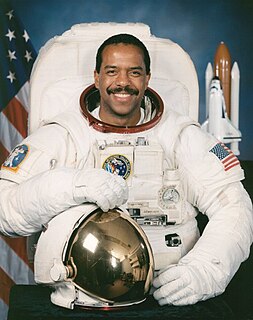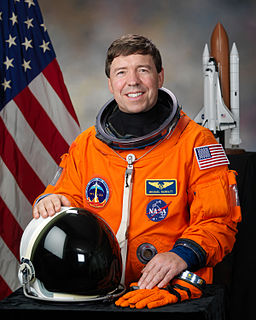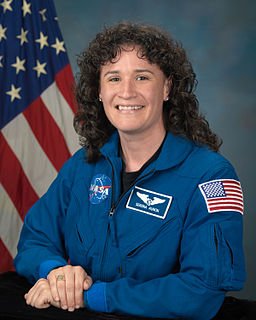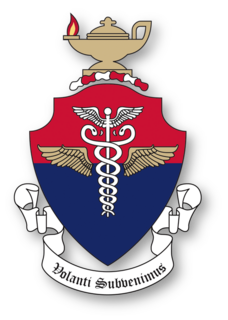Related Research Articles

David McDowell Brown was a United States Navy captain and a NASA astronaut. He died on his first spaceflight, when the Space Shuttle Columbia (STS-107) disintegrated during orbital reentry into the Earth's atmosphere. Brown became an astronaut in 1996, but had not served on a space mission prior to the Columbia disaster. Brown was posthumously awarded the Congressional Space Medal of Honor.
James Summers Forrester was a Republican member of the North Carolina General Assembly representing the state's forty-first senate district, including constituents in Iredell, Gaston and Lincoln counties. A physician from Stanley, North Carolina, Forrester died while serving his eleventh term in the state senate, in which he also served as Deputy President Pro Tempore.

Dafydd Rhys WilliamsOC OOnt CCFP FCFP FRCPC FRCP is a Canadian physician, public speaker, CEO, author and a retired CSA astronaut. Williams was a mission specialist on two space shuttle missions. His first spaceflight, STS-90 in 1998, was a 16-day mission aboard Space Shuttle Columbia dedicated to neuroscience research. His second flight, STS-118 in August 2007, was flown by Space Shuttle Endeavour to the International Space Station. During that mission he performed three spacewalks, becoming the third Canadian to perform a spacewalk and setting a Canadian record for total number of spacewalks. These spacewalks combined for a total duration of 17 hours and 47 minutes.

Norman Earl Thagard, , is an American scientist and former U.S. Marine Corps officer and naval aviator and NASA astronaut. He is the first American to ride to space on board a Russian vehicle, and can be considered the first American cosmonaut. He did on this on March 14, 1995, in the Soyuz TM-21 spacecraft for the Russian Mir-18 mission.

A reduced-gravity aircraft is a type of fixed-wing aircraft that provides brief near-weightless environments for training astronauts, conducting research and making gravity-free movie shots.

James Philip Bagian, MD, PE, is an American physician, engineer, and former NASA astronaut of Armenian descent. During his career as an astronaut, he logged 337 hours of space-flight, over two missions, STS-29 and STS-40. After leaving NASA in 1995, Bagian was elected as a member of both the National Academy of Engineering and of the Institute of Medicine. Bagian is currently the Director of the Center for Healthcare Engineering and Patient Safety at the University of Michigan.

Bernard Anthony Harris Jr. is a former NASA astronaut. On February 9, 1995, Harris became the first African American to perform an extra-vehicular activity (spacewalk), during the second of his two Space Shuttle flights.

Aviation medicine, also called flight medicine or aerospace medicine, is a preventive or occupational medicine in which the patients/subjects are pilots, aircrews, or astronauts. The specialty strives to treat or prevent conditions to which aircrews are particularly susceptible, applies medical knowledge to the human factors in aviation and is thus a critical component of aviation safety. A military practitioner of aviation medicine may be called a flight surgeon and a civilian practitioner is an aviation medical examiner. One of the biggest differences between the military and civilian flight doctors is the military flight surgeon's requirement to log flight hours.

Duane Edgar Graveline was an American physician and NASA astronaut. He was one of the six scientists selected in 1965, in NASA's fourth group of astronauts, for the Apollo program. He was best known for being immersed in water for seven days as part of his zero gravity deconditioning research while working as a United States Air Force (USAF) research scientist.
Hubertus Strughold was a German-born physiologist and prominent medical researcher. Beginning in 1935 he served as chief of aeromedical research for the Luftwaffe, holding this position throughout World War II. In 1947 he was brought to the United States as part of Operation Paperclip and held a series of high-ranking medical positions with both the US Air Force and NASA.

Space medicine is the practice of medicine on astronauts in outer space whereas astronautical hygiene is the application of science and technology to the prevention or control of exposure to the hazards that may cause astronaut ill health. Both these sciences work together to ensure that astronauts work in a safe environment. The main objective is to discover how well and for how long people can survive the extreme conditions in space, and how fast they can adapt to the Earth's environment after returning from their voyage. Medical consequences such as possible blindness and bone loss have been associated with human spaceflight.

Patricia Consolatrix Hilliard Robertson was an American physician and a NASA astronaut. She died in a plane crash the year before she would have flown to the International Space Station.

Luca Urbani is a former ASI astronaut and was assigned as an alternate payload specialist for mission STS-78.

Michael Reed Barratt is an American physician and a NASA astronaut. Specializing in aerospace medicine, he served as a flight surgeon for NASA before his selection as an astronaut, and has played a role in developing NASA's space medicine programs for both the Shuttle-Mir Program and International Space Station. His first spaceflight was a long-duration mission to the International Space Station, as a Flight Engineer in the Expedition 19 and 20 crew. In March 2011, Barratt completed his second spaceflight as a crew member of STS-133.

The Aerospace Medical Association (AsMA) is the largest professional organization in the fields of aviation, space, and environmental medicine. The AsMA membership includes aerospace and hyperbaric medical specialists, scientists, flight nurses, physiologists, and researchers from all over the world.

Colonel William Paul "Bill" Fife USAF (Ret) was a United States Air Force officer that first proved the feasibility for U.S. Air Force Security Service airborne Communications Intelligence (COMINT) collection and Fife is considered the "Father of Airborne Intercept". Fife was also a hyperbaric medicine specialist who was known for his pioneering research on pressurized environments ranging from high altitude to underwater habitats. Fife was a Professor Emeritus at Texas A&M University.

Serena Maria Auñón-Chancellor is an American physician, engineer, and NASA astronaut. She visited the ISS as a flight engineer for Expedition 56/57 on the International Space Station.

Josef F. Schmid is a German-American physician, NASA flight surgeon and a Major General in the United States Air Force Reserves. He served as an aquanaut on the joint NASA-NOAA NEEMO 12 underwater exploration mission in May 2007.

The United States Air Force School of Aerospace Medicine (USAFSAM) is the United States Air Force (USAF) organization focused on education, research, and operational consultation in aerospace and operational medicine. USAFSAM was founded in 1918 to conduct research into the medical and physiologic domains related to human flight, and as a school for medical officers trained to support military aviation operations, later coined as flight surgeons. The school supported early military aviation from World War I through the evolution of aviation and into the modern era. USAFSAM conducted medical research and provided medical support for the initial US space operations beginning in 1947 through the establishment of NASA in 1958. After the creation of NASA, USAFSAM continued to actively support civilian and military manned space missions through clinical and physiologic research. USAFSAM is one of the oldest continually operating school for flight surgeons and other operational medical personnel of its kind in the world. USAFSAM is located in Dayton, Ohio at Wright-Patterson Air Force Base, and is part of the 711th Human Performance Wing and the Air Force Research Laboratory (AFRL).

Julielynn Yee-Ching Wong is a physician, scientist and pilot, who is internationally recognized for using 3-D printing to deliver healthcare solutions to remote environments, including outer space. Wong is the founder and CEO of two organizations: 3D4MD and Medical Makers.
References
- ↑ "Obituary for Rufus R. Hessberg (Aged 74)". The News Journal. 1995-08-02. p. 1. Retrieved 2020-12-29– via Newspapers.com

- ↑ Saxon, Wolfgang (1995-08-01). "Rufus Hessberg, 74, Surgeon and an Expert in Aerospace Medicine". The New York Times. ISSN 0362-4331 . Retrieved 2020-12-29.
- ↑ "When Space-Age Imaginations Skyrocketed Into Reality". Los Angeles Times. 1995-05-12. Retrieved 2020-12-29.
- ↑ "Rufus R. Hessberg Dies; NASA Space Medicine Director". The Washington Post. 13 July 1995.
| This biographical article related to a physician in the United States is a stub. You can help Wikipedia by expanding it. |